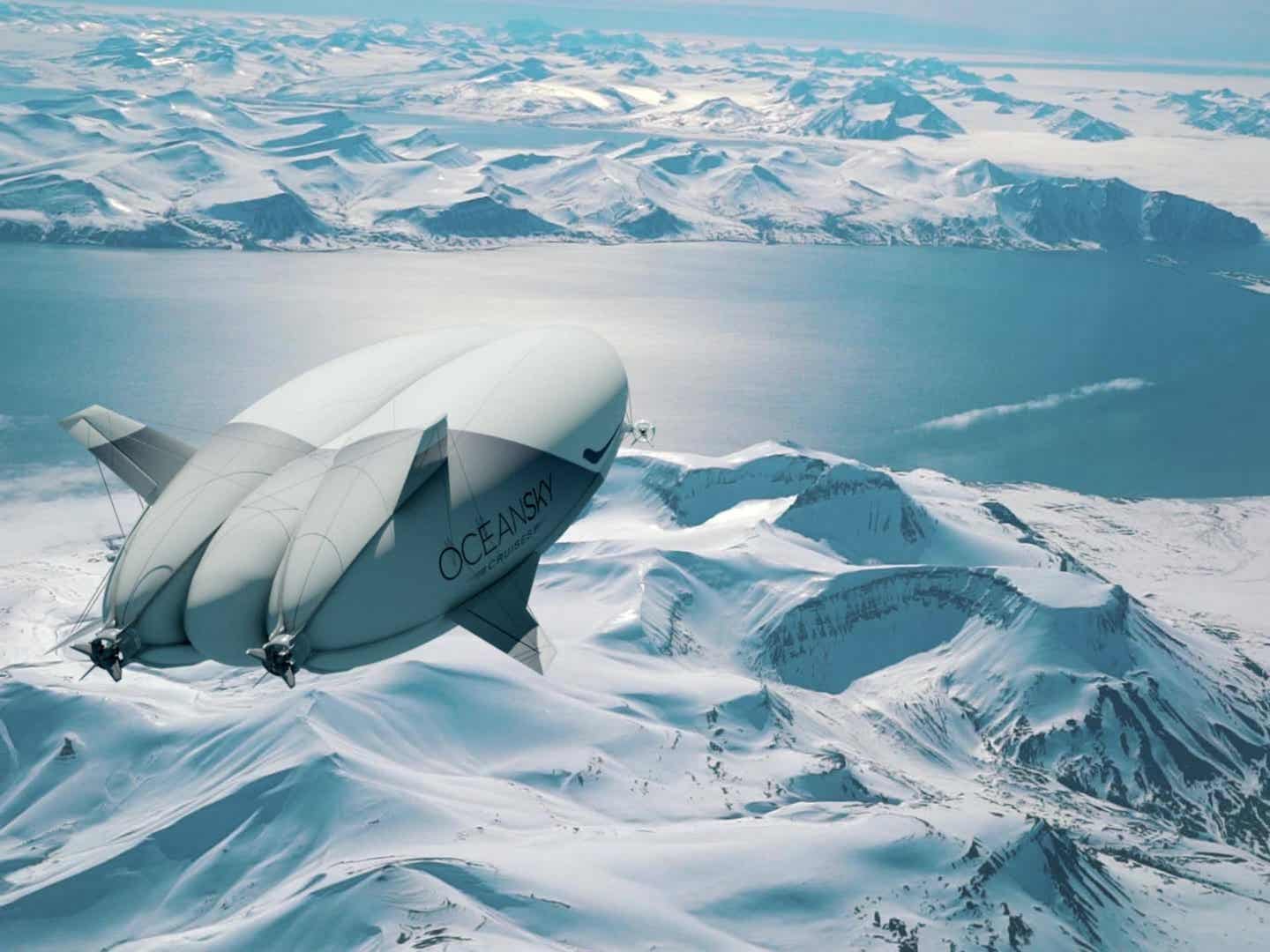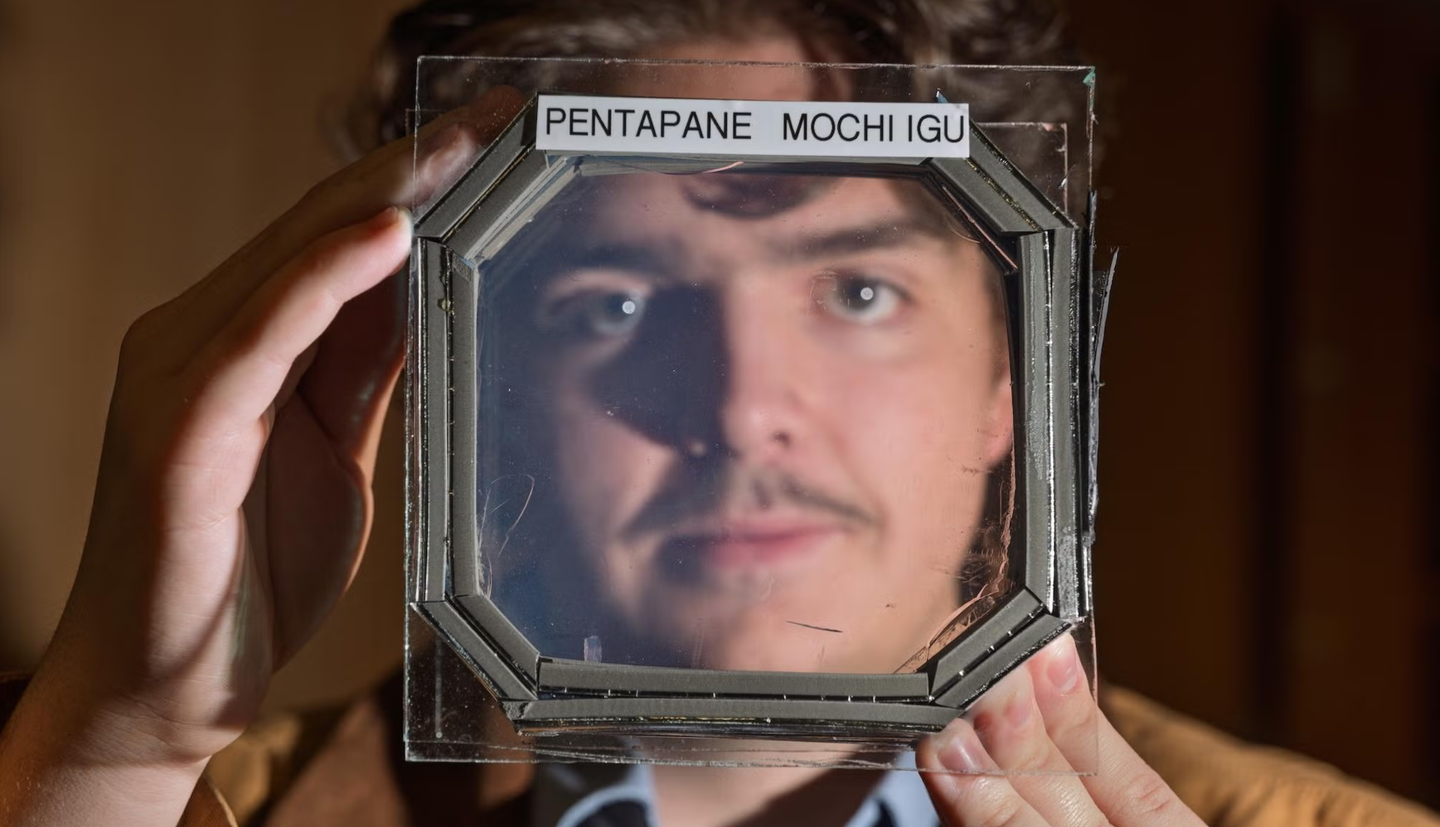Traveling to the North Pole in a new 21st century luxury airship
The spring of 2023 or 2024, the first airships will fly to the North Pole, almost a century after the first confirmed successful polar trip.

[August 18, 2021: Gemma Zo EUML]
The spring of 2023 or 2024, the first airships will fly to the North Pole, almost a century after Amundsen and Ellsworth completed the first confirmed successful polar trip aboard The Norge in May 1926.
The 36-hour trip round trip with Scandinavian expedition outfit OceanSky Cruises will depart Svalbard, one of the most northerly settled regions on earth – where the airship mast used by the Norge in the 1920s still stands – to cruise over Norway’s wilds and Arctic icebergs. From a cruising altitude of between 300m and 900m, passengers can use the midnight sun to their advantage as they look out for polar bears, breaching whales and rare wildlife below.
OceanSky CEO and co-founder Carl-Oscar Lawaczeck says it’s the first of many itineraries he will launch to explore hard-to-reach places.
“To utilise airships to the maximum, you want [to visit] an area that doesn’t have so much infrastructure, like Siberia or the Amazon, where it’s hard to get very deep into the wilderness,” he says.
OceanSky is already inviting travellers to apply to reserve their 900,000 Swedish Krona ($140,837), two-person cabin for 5 per cent down, but there’s a lot to be decided, including the date of departure and which airship they’ll be boarding. Several companies are exploring lighter than air (LTA) technology, although none have released a production model yet; that said, Lawaczeck names the 320-foot-long (97.5m) Airlander 10, manufactured by the UK-based Hybrid Air Vehicles (HAV) – which claims to be the only company to have flown a full-scale prototype – as their preferred candidate.
Airlander 10 is huge – 98m long, 43.5m wide and 26m high, with a payload capacity of 10 tonnes. HAV, which is on track to deliver production models in 2024, says it’s the biggest aircraft in the world.
Design Q’s Airlander 10 concept reimagines a superyacht for the skies with expansive suites, private bathrooms and floor-to-ceiling windows. (CREDIT: Ocean Sky Cruises)
On paper, dirigibles have the potential to achieve a sizeable share of the aviation market. For one thing, they’re relatively safe. Unlike the highly combustible hydrogen of yore, helium is inert, so unlike the Hindenburg, the new airships won’t explode. They’re also not susceptible to popping. Even in the unlikely event the hull suffers multiple punctures, its low pressure differential means the helium would escape so slowly that the airship would have plenty of time to cruise back to base to get patched up.
Because airships travel slowly – the Airlander 10 maxes out at 111km/h compared to a Boeing 737’s average cruising speed of just over 1040km/h – potential for damage in the unlikely event of a crash is greatly reduced.
“By travelling slowly and landing slowly, you’re mitigating the worst risks with landing and take-off. And that’s where the biggest risks are,” says Lawaczeck, who has worked as pilot in cargo operations, VIP corporate airlines and legacy passenger airlines over his career.
You can see a slow airship crash in extra slow-mo for yourself on YouTube. During the second of six test flights, in August 2016 HAV’s prototype Airlander 10 gently nosedived into a meadow, bouncing back off the ground. The flight crew’s feathers were probably somewhat ruffled but HAV says the aircraft was undamaged.
While this caught-on-camera snafu isn’t exactly reassuring, Lawaczeck says HAV, and the airship market generally, have a good handle on technical risk, and the fact that HAV allowed media to record the event highlights the LTA sector’s greater transparency, compared with jet manufactures such as Boeing and Airbus.
“When you test fly, you test to the limits and things happen. That’s normal when you’re developing a new technology,” he says.
Airships can take off and land from virtually any flat surface so there’s no need for runways or airports, giving them licence to go anywhere in the world, within range. Airlander 10, for instance, can stay airborne for five-days and travel 4000 nautical miles. This has the bonus of being in step with the luxury travel sector’s “leave no trace” philosophy. Whereas cruise ships have to break apart ice floes to reach the North Pole – a region that’s already a focal point of climate change discussion – the airship will glide quietly overhead, leaving the landscape untouched.
Moving into LTA tech is also a great way for the aviation industry to reduce its carbon footprint by reducing emissions of the greenhouse gas carbon dioxide. Airships’ bulbous proportions may look comical from certain angles – the Airlander’s ample posterior earned it the nickname The Flying Bum – but the design is extremely efficient. Because most of the airframe’s weight (between 60 and 80 per cent) is countered by the buoyancy of helium, the airship requires much less fuel to stay airborne, offering a reduction of 75 per cent on emissions compared with more traditional aircraft.
Lawaczeck says OceanSky will offset the carbon emissions it does produce and use clean fuels such as biofuel or EcoPar Ultra Clean. The latter is synthetically made from natural gas for 90 per cent fewer carcinogenic substance emissions than regular diesel oil, and up to half the nitrogen oxide emissions.
Airships provide opportunities to leverage solar and hydrogen fuel cells and tap renewable energy, and in time Airlander’s four jet-fuel-burning engines will be replaced by hybrid and electric engines. HAV engineers are partnering with the University of Nottingham to produce a fully electric, zero-emission version of the Airlander for 2030.
Because Airlander combines several aerospace technologies – hull fabric and helium common to dirigibles, aerodynamic lift similar to fixed-wing aircraft, and vectored thrust similar to a helicopter – HAV says it’s more reliable than any one type of aircraft. Airships are low vibration, with a greatly reduced effect of turbulence – so no more mid-flight hot-coffee crotch incidents. They’re also very quiet, making them perfect for low-key pick-ups in residential areas or getting close to wildlife on an aerial safari. Imagine following the great wildebeest migration, glass of champagne or single malt in hand as two million animals crash through the Serengeti bush and the Mara River below. These features make airships suited to a range of sectors outside of luxury travel.
An airship’s long range and high payload capacity also have defence and security intelligence applications – for instance, transporting goods and personnel to war-torn regions lacking infrastructure, and enabling surveillance, intelligence and reconnaissance missions. They can help groups track the evolution of abnormal events and provide clear aerial pictures of a battlefield. They pack plenty of power, so they can support advanced computer systems and technologies. And because they can stay airborne for many days, one airship can replace multiple aircraft.
The same qualities make airships ideal for commercial and logistics applications, such as hauling mining or logging gear as well as personnel straight to a site. They can easily deliver aid to remote communities and disaster-affected regions, and shipping by airship is likely to prove less risky and much faster than sea freight.
An independent 2017 report by Renaissance Strategic Advisors forecast that the market for primary Airlander sales over the next 20 years will be worth $46 billion, representing more than 500 aircraft.
To date, more than £150 million ($263.2 million) has been invested into Airlander’s development by the UK, EU and US Department of Defense. Even armchair investors were offered a piece of the action via the crowdfunding application CrowdCube. At the time of writing, HAV had smashed its latest £1 million target, raising £1,900,490 from 1629 investors in exchange for shares in the company.
And the technology is extremely scalable. HAV’s design for Airlander 50 can manage a 60-tonne payload and the cabin can accommodate 200 passengers. Airlander 200 will up the ante, with capacity for 200 tonnes.
“We can build a ship that has a thousand tonnes in payload with today’s technology but it’s going to take a lot – maybe decades – before we get there,” says Lawaczeck. He adds that an airship’s economy of scale will reduce the cost per ton by 75 per cent every time capacity is doubled – a market proposition many companies are exploring.
In pursuit of military contracts, Lockheed Martin flew its experimental Hybrid Air Vehicle P-791 at the company’s California flight test facility in 2006. Designed as an unmanned or manned intelligence gatherer or transport, it can stay airborne for up to three weeks at an altitude of 20,000 feet. The team is ready to begin construction of its first commercial model and complete the FAA Type certification process.
French company Flying Whales – which, ironically, is making a sleek, torpedo-shaped dirigible – pledges to “connect the landlocked world with the global economy” but there’s no sign on its website of when that might be.
Engineer Igor Pasternak founded Worldwide Aeros Corp. (Aeros) in the US 25 years ago and the firm’s products, including its non-rigid Aeros 40D Sky Dragon airship, tethered aerostatic systems and portable communications and surveillance towers are already used by commercial and military organisations. Now the firm is focusing on delivering its Aeroscraft airship. The largest in the four-model fleet, the ML 86X, can carry 455 tons.
Initially, Lawaczeck too was interested in exploring the applications of LTA technology in the cargo sector, but he says the risk-reward ratio for private capital investment was out of whack because a developed market was lacking. For him, experiential travel is a way to get the industry airborne, as it were.
He also says airships are a great proposition for passengers who want to get from A to B and use the journey time productively. Instead of counting down the minutes until you can unfold yourself from an economy airline seat, on an airship you can use the time to do yoga, work, enjoy a dinner, or just get some quality shut-eye to arrive refreshed at your destination the next morning. Carriers who ground aircraft overnight due to lack of passengers willing to forgo a night’s sleep can instead keep their fleet in the air and make money, helping to keep tickets costs manageable. On some routings, the fact an airship can cut down the commute by dropping you right in the city might mean the total journey time beats that of commercial airliners, when traffic to the airport, security and runway-clogging weather can cause major delays.
And for well-heeled explorers and aesthetes, the onboard passenger experience will be a game changer. OceanSky’s cabin is projected to be 46m long – larger the A320’s – for just 16 passengers, four pilots and three service staff. These colossal dimensions enable designers to rewrite the book on accommodations.
Creative consultancy Design Q, which specialises in automotive and bizjet design and engineering, created an Airlander 10 concept with a superyacht feel, reimagined for the skies. Each expansive suite will feature a queen-size bed, dresser and private bathrooms – possibly with a soaking tub – and floor-to-ceiling windows in the standard cabin. CEO Howard Guy says there’s potential to change the cabin configurations between flights to create more expansive suites when fewer passengers are aboard. There are also several common areas, including a “horizon-to-horizon” infinity lounge for drinking, dining and watching the world glide by through huge 2.5m by 1.5m windows.
Because airships are low-g and carry few passengers, materials and furnishings onboard aren’t held to the same stringent toxicity, smoke and crash test standards, giving designers a wider choice of luxe finishes and fixtures – think plush fabrics and gleaming wood veneers. Guy hints that they’re planning to reveal innovations in light and heating, but he couldn’t possibly comment as to whether that might mean you can cosy up to gas fireplaces.
The fact that airships cruise at low altitude and aren’t pressurised means that passengers can breathe easier, sleep more deeply, and better savour food and drink. Seating will be dynamic so spaces will take on a different mood as the day moves through lunch to cocktail hour and Arctic cuisine-themed dinner, and even move outboard to create a dance floor come disco hour.
“It’s about theatre,” says Guy. “We’re trying to make the journey slightly less predictable.”
Lawaczeck says he’s interested in exploring a nostalgic heritage design that evokes the romance of 1900s airship travel down the line, and says the response to the invitation-only Arctic trip has been “above expectation”. He’s already laying the groundwork for a Tropic of Capricorn itinerary that will take in Botswana’s vast, biodiverse Okavango Delta; Namibia, where cheetahs roam striking red sand dunes; and the majestic 1708m -wide Victoria Falls along the Zambezi River in Zambia.
And if you want to take an airship to go wine tasting through Champagne rather than a helicopter or Ferrari from Paris, that’s an option.
“Flying aboard an airship is basically bringing your luxury hotel with you,” says Lawaczeck.
Like these kind of feel good stories? Get the Brighter Side of News' newsletter.
Tags: #New_Innovations, #Green_Good_News, #Airship, #Air_Travel, #Luxury, #North_Pole, #The_Brighter_Side_of_News



